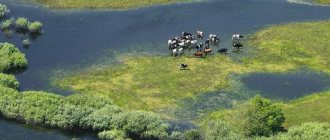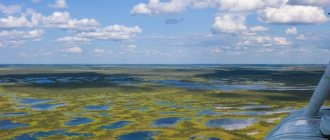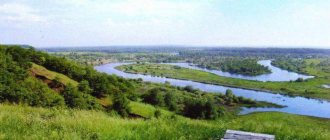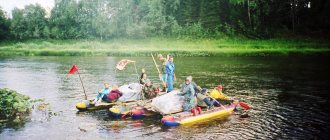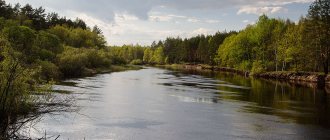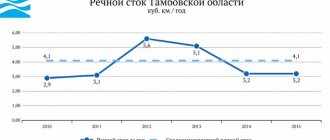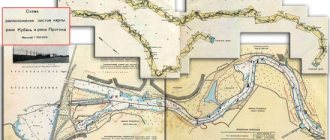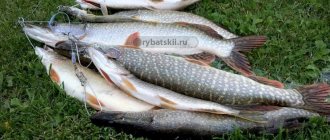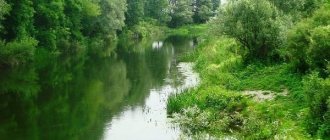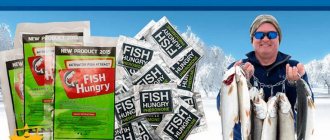Home → Blogs → 05/11/2015 // For chub on the Sal River.
I haven't gone fishing for a long time. And it is aimed specifically at chub, and even more so. In the district of Novocherkassk (where I now live) the rivers are mainly classified as spawning. Fishing is strictly prohibited until June 1. Taking advantage of the gap in business and the current circumstances, I decided to expand the geography of my fishing trips a little and go fishing on the left tributary of the Don, the Sal River. Zaranie began collecting information. I read fishing forums, talked to experienced people, and studied maps. There was a lot of information and most of it was contradictory. But certain conclusions were drawn. A small group of like-minded people decided to explore an area near the mouth of the river near the village of Kostylevka. We didn’t go very early, because we wanted to see what was what in the light. We arrived at the place around 9 am.
From the bridge I tried to get a good look at the river. The width is no more than 30 meters. The current is moderate, but not equal. The Sal is very tortuous in these places and the stream at the turns either dies down completely or accelerates, forming rapids. The water in the river turned out to be somewhat cloudy, probably as a result of the recent rains.
I wanted to explore as much of the coastal area as possible. In order not to burden myself with an extra burden during the hike, I took a minimum of gear. Several packs of working silicone, and a couple of boxes with chub wobblers and spinners. I took a universal fishing rod, Tiro up to 12 grams, this spinning rod will allow me to cope equally well with any bait within the test.
Behind the bridge pilings, the river formed a small riffle that flowed into a rather large hole. You couldn’t imagine a better place for a chub to stop. My friends went far ahead, and I stayed here for a good hour. I was happy to sort through my favorite wobblers for catching chub in the box and took turns bathing them in the stream, admiring the game and remembering the wiring technique. The chub did not respond. And I continued to fish the place, simultaneously admiring the surrounding spring nature and the wonderful morning. Opposite me, swallows were picking up clay with their beaks to build their nests.
Usually in good weather in such places the chub is easy to see. I felt its presence with my sixth sense, but did not observe it visually.
Time passed, I decided to move on, but I took note of the place. A minute later I met a hedgehog on the shore. Prickly, probably hobbled to the river to hunt frogs and snakes, but there were plenty of them here, and it was a little annoying.
In order to more clearly understand the structure of the bottom, I began to break through the channel with a light jig, constantly moving.
On one of the bends of the river, on a micro-return, I found a school of small pike perch and nibbled it a little. And the small fanged ones, in turn, nibbled my silicone supply, rendering it unusable with their sharp, merciless fangs.
In one place, where the current died down, I had a series of strange bites. Using a light weight, I suspended the bait in the water column and slightly played along with it while it slowly sank. The bites happened during a pause, when the bait was already lying at the bottom. And they no longer looked like a blow, but like a tug. As if the fish, having carefully taken the bait, went downstream and the tip of the spinning rod bent like a quivertip on the feeder. Hooking did not bring any results. It all ended with the bait being pulled, or the tail being broken off, and once the fish simply tore the silicone off the hook. I was perplexed.
Fishing on the Sal River
Came from fishing on the Sal River. We fished together with a friend from September 9 to 15 (mostly on the feeder). I have long been waiting for the moment to repeat the sacramental phrase of one of the respected Furom residents: “Of course there were no monsters, but I pulled out fish more than 10 kg.”
Now the report. The main catch was on Monday and Tuesday (about 2/3 of all fish caught). Starting on Wednesday, there was a sharp decline in the water level and, accordingly, the bite. In addition, according to a local fisherman, electric fishing rods were seen upstream (so that they were spread open and torn apart to feed the fish). The catch included: a hybrid (well, what would we do without it), white bream, bream, roach, pike perch, pike, catfish, carp, cupid, ide, perch, goby and crayfish (one reptile took the bait). I haven't enjoyed diversity so much for a long time. We caught a lot of fish. They only took from 500 grams and above. Photos of the trophies were taken on a phone, with dirty, shaking hands, in poor lighting conditions and poor skill in this noble task. So we ask for forgiveness. Well, I’ll post what I have. We caught it behind the Shaminka farm (so to speak, on the way to the respected Crok’s fishing patrimony). The trophy specimens (at least for me) were: carp 7.200 kg; cupid 11 kg; pike 6,100 kg and catfish 4,500 (let it be). The rest are smaller. Total: 2 carp, 2 carp, one catfish, 8 pike, 2 pike perch, 24 bream, the rest were not counted. There were also adventures. For example, during night fishing, after casting a feeder, I almost broke the rod twice (still holding it in my hand) from a freaking jerk right on the fall. I am sure that I was hooked on a silver carp, whose back I saw clearly several times. But the leashes tore immediately (the equipment was for a different fish, so the main target was bream). And so the night was practically wasted. The main catch was in the morning and evening. Sazanov took strawberries for boilies. Amurov on the reed. For corn, only a hybrid and a couple of bream. The predator didn’t care about all the iron and rubber that we offered him in every possible way. It was caught only with live bait in the “fool” rig. By the way, a hybrid of 1 kg or more was caught on a small live bait several times. The result of another experiment: bream bite on pieces of SALA in the SAL River just as well as on Seliger. I recommend trying it in cold water. Another example of the fact that you need to listen to the words of experienced fishermen (Ossetian, I mean you). After casting the feeder, when the hand was already reaching for the baitrunner lever, the rod literally shot into the river. Only the fingers closed in the air. With longing, I watched my faton-pro go under the water at a decent speed. But an hour later, quite by accident, a feeder from another rod pulled up a cord that turned out to be from my feeder. It turns out that the free end of the cord caught on a snag, but the second was firmly tied to the reel. The line was completely unwound from the reel, but the fishing rod was not hooked. So to my trophies I should also add the new Faton Pro, a Kasadaka reel with a byte and a Proshka 0.22 cord.
Geographical information
In the area from the source to the mouth of the Sukhoi Sal River, the river is known as Khamkhurka. The Kara-Sal originates on the western slopes of the Ergeni upland and flows into the Sal 533 km from its mouth. The length of the river is 134 km, the basin area is 3070 km².
The river basin is located in the steppe zone. The river flows in a wide floodplain valley with a shape close to trapezoidal. The width of the valley bottom is 200–300 m. The river bed is predominantly meandering, replete with reaches and rifts. The banks are relatively steep, with a height of 3 to 6 m. The width of the channel varies along the river from 5-10 m in the upper reaches to 20-30 m in the lower reaches. The depth of the channel on the reaches reaches 1.7-2.0 m, on the rifts it decreases to 0.1-0.5 m. In summer, during deep low water periods, the rifts dry out, turning the channel into a chain of unconnected lakes. Due to the fact that the channel is intensively overgrown with higher aquatic vegetation, the flow speed during low water does not exceed 0.1 m/s.
The river is fed predominantly by snow (its contribution to the river’s water flow is up to 90%). The river's water regime is characterized by high spring floods and stable summer-autumn low water periods with rare rain floods. Winter low water is stable, occasionally interrupted by floods as a result of the onset of thaws. The spring flood begins in the first ten days of March. The average duration of a flood is about 1.5 months. The most wet month is March. Summer-autumn and winter floods are rare. The river often dries up from June to November. The range of seasonal fluctuations in water level is about 2.5 m.
The first autumn ice phenomena on the river are observed at the beginning of the second ten days of November. Often the river freezes without autumn ice drift. Freeze-up occurs in the first ten days of December and lasts 110–120 days. The ice cover begins to collapse in March. After a short ice drift, the river is completely cleared of ice. The average duration of the period with all ice phenomena does not exceed 120 days.
Main tributaries: r. Kerkrea, b. Sukhoi Sal, r. Akshibay.
The banks of the river are inhabited. Some settlements (Kanukovo, Salyn-Tugtun, Shebalin) are accessible by paved roads.
river bed
The Sal channel is laid among terraced deposits and rises somewhat above the surrounding valley. The banks are composed of loess-like loams.
The channel is predominantly shallow, especially in the middle reaches, between the Ilyinov farmstead and the village of Yuzhny. However, along with shallow water in the channel there are deep reaches, reaching 5-7 m in low water, as, for example, above the Krepyanka farm. There are many outlets of powerful sources in the riverbed. This is explained by the fact that groundwater lies 2-5 m above the low-water level of the river, due to which the river drains the surrounding surface, sucking out its water. Sometimes springs emerge on the slopes of riverbeds and valleys, causing swampiness. In the lower reaches, due to the lowered flat topography of the valley, swampiness is almost constant, since water, lingering in all small depressions of the relief in addition to oxbow lakes, locally called "chigonaki", densely overgrown with reeds, forms a significant water surface, and in the mouth area swampiness occupies a dominant position. In many places, the river bed is so overgrown with reeds that the water surface is invisible even at close range. Waterlogging contributes to the annual deposition of sediment in the floodplain after high water spills, reaching from 3 to 20 cm.
Change of channel
Until 1915, the Sal flowed into the Don near the village of Razdorskaya. However, during the flood of 1915, the Sal, having flooded the low banks, broke into the previously outlined channel and now flows with a short branch 2.0-2.5 km below the city of Semikarakorsk, having at the very mouth a narrow channel, about 14-18 m wide, despite due to the fact that the width of the channel in the lower reaches is 80-100 m.
Hydrology
The upper Sal basin is characterized by the most arid climate. Precipitation here is about 300 mm per year, and evaporation, due to high summer temperatures, prolonged dry winds and, therefore, low relative humidity, is extremely high. Due to these climate features, the role of summer precipitation in feeding the river is small. The flood occurs in March - April, in some years, after snowy winters, with a large rise in water levels. The average annual water flow at the mouth (near the village of Batlayevskaya) is 15 m³/sec, 205 km from the mouth - 9.9 m³/sec.
| Estimated maximum water flow rates at the mouth (m³/sec) |
The river is characterized by summer-autumn low water, which is sometimes interrupted by rain floods. In the upper and middle reaches, it dries out in summer from 8 to 200 days in different years. In its middle reaches, the river receives water from the Tsimlyansk reservoir through the Don Main Canal. Sal freezes in mid-December, the ice cover is unstable and lasts until the end of March, and in rare severe winters it freezes in the upper reaches.
